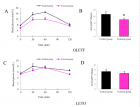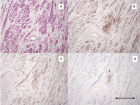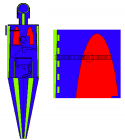Table of Contents
McArdle’s Disease (Glycogen Storage Disease type V): A Clinical Case
Published on: 31st December, 2018
McArdle’s Disease, or Glycogen Storage Disease Type V, is the result of a deficiency in one of the enzymes responsible for the metabolism of glycogen in the body. Individuals with this disease, lack or produce very small concentrations of the myophosphorylase or glycogen phosphorylase enzyme.
McArdle’s disease is a metabolic and recessive genetic disease caused by a mutation on the PYGM gene located on chromosome 11q13. This gene is responsible for the synthesis of the myophosphorylase (or glycogen phosphorylase) enzyme. It is the most common form of muscular glycogenesis. We present here the clinical case of a 35 years old woman diagnosed with McArdle’s disease at the age of 21 after a visit to a Neurologist. It was confirmed that the patient had shown symptoms of this disease at least 10 years before definitive diagnosis: intolerance to exercise, asthenia and muscular weakness. In this report we describe the different signs and symptoms of the disease, as well as the tests performed to confirm the diagnosis by muscle biopsy and genetic analysis. McArdle’s disease is classified as a rare disease and often its diagnosis is delayed due to a lack of knowledge about its symptoms and signs. Our intention is to make, with the description of our clinical case, the information about this disease more available to physicians to prevent future misinterpretations and delayed diagnosis. A medical documentary we have created on “McArdle’s Disease” can be seen in YouTube using the following links: https://youtu.be/HAhoZ7jxz7Q (English version) and https://youtu.be/uZopzSHOl20 (Spanish version).
Brooke-Spiegler Syndrome: A rare cause of skin appendageal tumor
Published on: 1st November, 2018
OCLC Number/Unique Identifier: 7912402820
A 51-year-old women presented with asymptomatic multiple polypoidal nodules over scalp with simultaneous papularnodular skin eruptions involving nose, nasolabial folds and forehead for 40 years duration. Her daughter also noted to be having multiple papularnodular skin eruptions involving nose, nasolabial folds and forehead which raised curiosity of possible familial condition. The punch biopsy of polypoidal nodule indicating histological evidence of spiradenoma was favour in diagnosis of Brook Spienger Syndrome. We report this case as this is a rare clinical entity.
A rare case of Diabetic Foot in male of middle age has been shown Diabetic foot
Published on: 13th October, 2018
OCLC Number/Unique Identifier: 7877944611
A rare case of Diabetic Foot in male of middle age has been shown.
Meige Trofoedema: A form of primary lymphedema
Published on: 24th April, 2018
OCLC Number/Unique Identifier: 7666332267
The lymphatic system consists of small non-contractile lymph vessels which collect fluid from the interstitial space and carry it to the major contractile lymphatic vessels with valves that maintain a unidirectional flow to the lymph nodes and is responsible for returning proteins, lipids and water from the interstitium to the venous system near the junction of the subclavian vein and internal jugular vein on both sides. Lymphedema would be the result of the failure of transport with the further accumulation of fluid rich in protein at the interstitium, especially in limbs.
Primary lymphedema, which affects 1.15 / 100000 children (especially pre-pubescent girls), not always clinically evident at birth, is a genetic disorder that represents many different subsets of phenotypes: congenital or congenital lymphangiectasia, congenital trofoedema family or Meige, congenital amniotic band and essence or idiopathic.
The most common form of presentation is due to congenital absence or abnormality of the lymphatic tissue caused by a genetic mutation of the genes responsible for the development of lymphatic vessels that is characterized by the difficulty of draining lymph vessels. This genetic alteration may be sporadic or inherited.
Trauma to the neck: Manifestation of injuries outside the original zone of injury-A case report
Published on: 6th February, 2018
OCLC Number/Unique Identifier: 7355942994
A 53-year-old male presented to the Emergency Department (ED) with multisystem trauma and respiratory distress following a blunt-force injury to his anterior left neck. CT imaging showed extensive subcutaneous emphysema and pneumomediastinum. A chest X-ray showed elevation of the left hemidiaphragm suggesting phrenic nerve injury which was confirmed by bedside ultrasonographic examination of the left hemidiaphragm. Flexible bronchoscopy demonstrated tracheal rupture. The patient was treated supportively and recovered without surgical treatment. Trauma-induced hemidiaphragmatic paralysis is rarely reported. This case represents a clinical scenario with demonstrable anatomic correlations, and a clinical reminder that phrenic nerve injury should be included in the differential diagnosis of respiratory distress in a trauma patient.
A rare case: Congenital Megalourethra in prune belly syndrome
Published on: 30th January, 2018
OCLC Number/Unique Identifier: 7355941035
Introduction: Prune Belly syndrome is a disease characterized by abdominal muscle defect, bilateral cryptorchidsim and urinary system anomalies (reflux megaureter, hydronephrosis, etc.). Pulmonary, cardiac, and gastrointestinal anomalies may also be present. Management of these rare cases is very important. In this case, the clinical course of a patient with Prune Belly syndrome with megaurethra is presented.
Case: The patient from the first gestation and parturition with birth weight of 2500 g and 38 weeks was hospitalized because of the bilateral hydronephrosis. His physical examination revealed undescended testicles and a large penis. The abdominal muscles were not very atrophic. The size of the kidney was small, bilateral hydroureteronephrosis and wide posterior urethra on the ultrasound. Renal function tests were progressively disturbed and the patient underwent cystourethroscopy for diagnostic purposes in terms of posterior urethral valve. A large diverticulum was found in anterior urethra. Prune Belly Syndrome was thought because the orifices were in appearance of reflux. The vesicostomy was applied. After vesicostomy the renal function tests got better but he was hospitalized due to urosepsis two times. In cystoscopic examination, the diverticulum in the urethra was filled with urine and the drainage was very slow. Phimosis was opened with dorsal slit technique. Cutaneous urethrostomy was proximal to the anterior diverticulum.
Conclusion: Prune Belly syndrome should be considered in patients with megaurethra and postrenal or renal insufficiency although there are no obvious clinical findings. In Prune Belly cases, via a large penis with obstruction signs, anterior urethral diverticulum should be considered.

HSPI: We're glad you're here. Please click "create a new Query" if you are a new visitor to our website and need further information from us.
If you are already a member of our network and need to keep track of any developments regarding a question you have already submitted, click "take me to my Query."


























































































































































